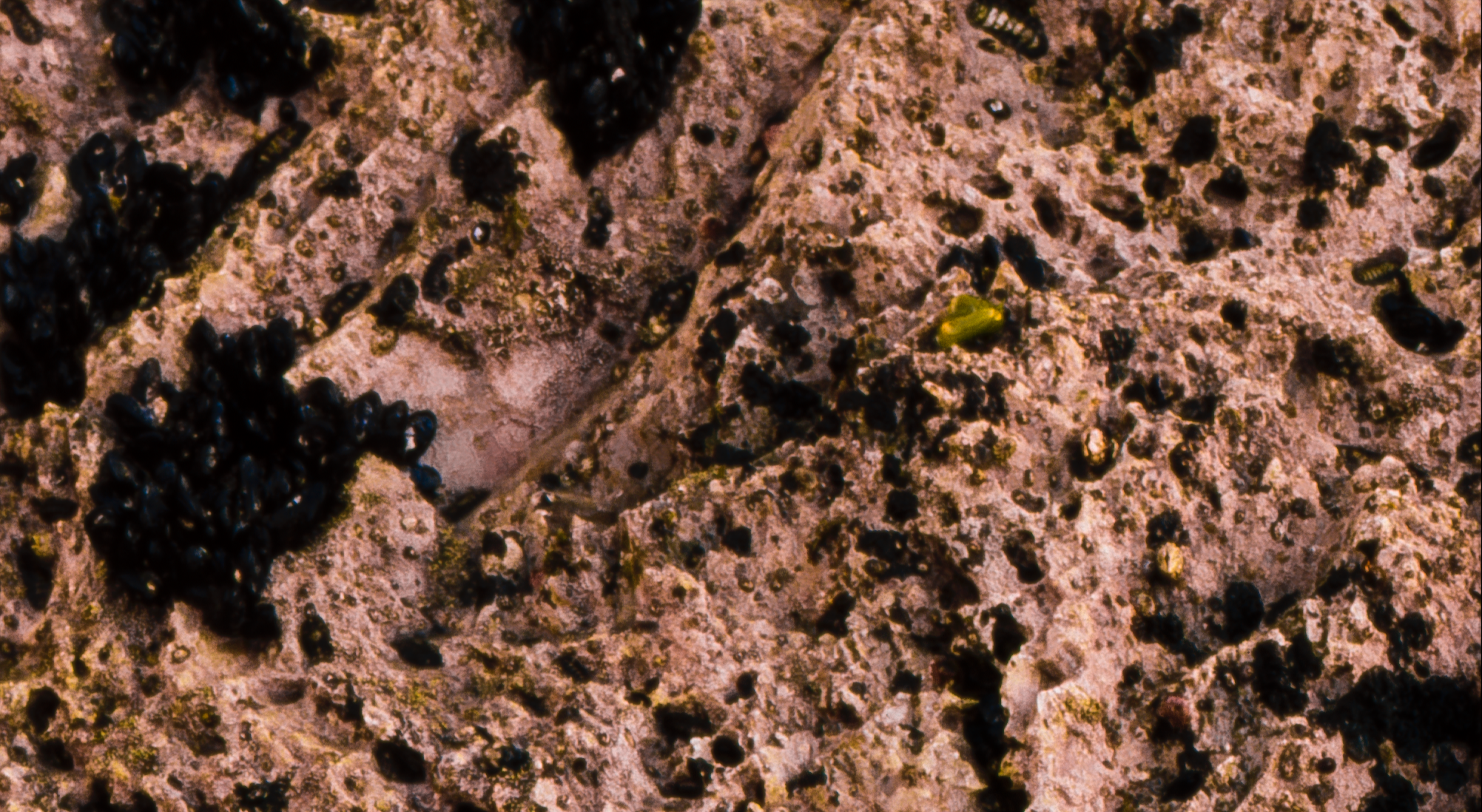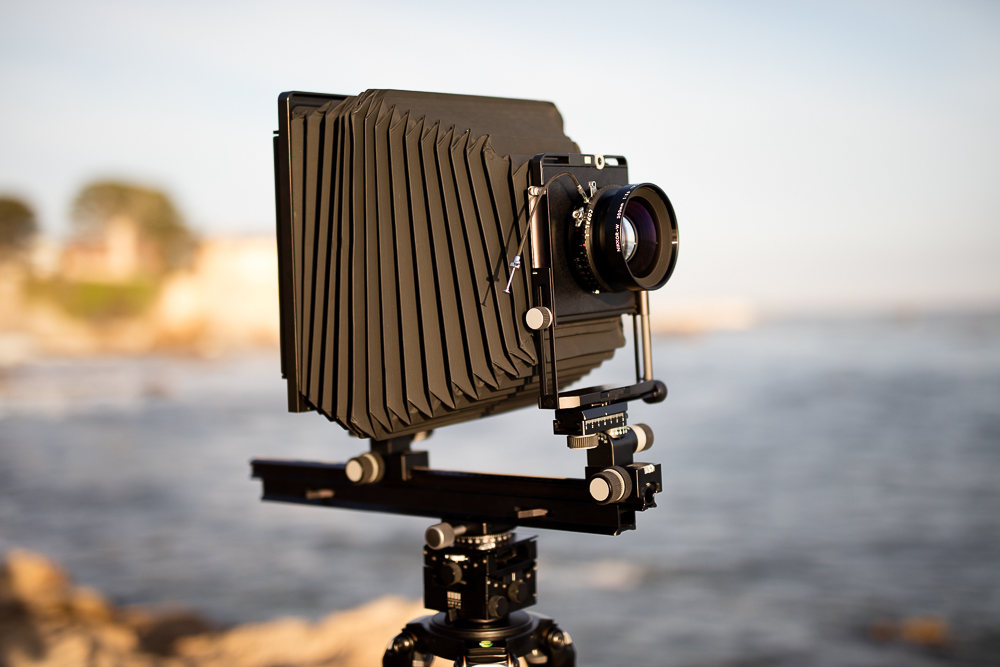A couple of months ago, I upgraded my camera system yet again to an Arca Swiss F-Line Metric with Micrometric Orbix. This camera is arguably the best large format camera on the market today, combining the old school heart and soul of film with modern technology. Arca Swiss has done an absolutely fantastic job designing and constructing this camera. Even opening the packaging and putting together the camera for the first time, I could feel the precision and engineering involved with developing this line of cameras.
Not only did I upgrade cameras, but I upgraded film size as well...all the way up to 8x10, which...if you're quick on your feet, is four times the area of 4x5 film. What this means, is unparalleled quality of images. Here's an example of the quality of 8x10 transparency film.
At first glance, it doesn't look like much...just a sharp image of some ocean waves crashing against a rock full of barnacles. Below is a 100% crop of the same image. See if you can figure out where that came from.
I bet you can't. This image was scanned on my Epson V800 scanner, one of the better flatbed scanners on the market, with a custom film holder to raise the film slightly above the surface of the glass. What you're seeing is a 100% crop from an image roughly 22,000 x 18,000 pixels wide...over 350 megapixels. A drum scan would pick up even more detail and sharpness from this image, allowing me to print practically as large as I'd like.
Although it may seem like a perfect solution for modern photographers who wish to print incredibly large, there are a number of fairly large drawbacks. Firstly, the weight of the camera is a killer. Fully loaded up in the pack with my smaller tripod, the pack weighs in at roughly 45 lbs. That's two lenses, the camera (rail included), tripod, shutter releases for each lens (I just keep one on each lens), filters, filter holder, film holders, light meter, and loupe. And I plan on taking this camera into the backcountry later this summer.
Another challenge is wind. This camera is huge and fairly lightweight for its size, so any sort of wind has the chance of shaking the front and rear standards and blurring the image I'm exposing. This is usually fought with either an umbrella or a jacket I hold out to block as much wind as possible, which seems to do the job fairly well. The image of the waves crashing against the rocks above was taken in winds exceeding 30 MPH and the exposure was over 8 seconds.
The most obnoxious challenge to me is probably the constant battle with depth of field. For landscape photography, I generally try to keep everything in focus, from the foreground all the way to infinity, so to speak. I won't get into the physics, but with such a large film area, this means incredibly small apertures to maintain depth of field. Fortunately with large formats, the ability to tilt the front and rear standards help me to fight the need this remarkably, but I still find myself at f/45 to f/64 for every exposure if I'm trying to keep everything in focus. And sometimes even at f/64, I have to be selective on what I'd like to be completely sharp.
Getting into a few features of this camera, I'll start with the basics. This is considered a monorail camera. Unlike my field camera, which collapses into a nice little wooden box, this camera has a gear track along a rail. This allows me to photograph with a very wide variety of lenses (although I only use two) but also allows me to extend the bellows out for macro focusing. The nice thing about the Arca Swiss is the rail is modular, meaning you can pick and choose the length of rail you wish to carry along with you. For me, I chose to have a short 6 inch rail and a longer rail. This allows me to completely pack up the camera on the 6" rail, slide it off, and slip it into my pack. Then the rest of the rail packs alongside my tripod on the outside of my pack.
I have two lenses for this camera, a Nikkor 300mm W, which is a normal lens (roughly a 50mm on 35mm full frame camera standards) and a Schneider Super-Symmar 150mm XL, my wide angle lens (roughly 16-18mm on 35mm standards). With these two lenses, I can achieve nearly all of the shots I'd like to photograph and are both incredibly sharp.
Both lenses are very fast (f/5.6), which means I can focus them relatively easily in low light, especially on the very fine Arca Swiss ground glass. The 150mm has a slight vignette of about 1.5 stops, but I typically don't find it to be a problem, even when shooting slide film. There is a center filter ND for it to balance this out, which I have, but it prohibits me from using my 100mm ND graduated filters and my polarizer.
Another fantastic feature about this camera is all of its geared movements. Aside from swing, every movement available on this camera is geared. So if you need to change composition or focus, all you have to do is turn a knob and it's corrected. This allows for incredibly precise compositions and focus, which is absolutely essential for shooting such large film.
My favorite feature of the camera has to be what is known as the Micrometric Orbix. What this means is the front standard tilt (which is essentially base tilt...and is also geared) moves asymmetrically. In other words it rotates on the same plane as the film. What this allows me to do is choose a focus point in the distance and tilt the front standard to achieve my near focus point without having to refocus the far point. Essentially, what would usually take me several iterations with my old 4x5 field camera is now done in a single step. This allows me to concentrate more on my composition and precise focus rather than taking more time to ensure my focus is correct.
Overall, the camera has been a dream to use. I have a number of images I'm waiting to release, so be sure to continue to keep a look out over the next couple of months. If you have any questions, please feel free to ask them in the comments below or drop me an email.
Each sheet of film I expose costs nearly $50 to present to you online. If you enjoy seeing my content and enjoy hearing about my experiences, feel free to donate using the button below. Anything helps!







